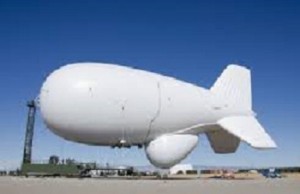Military Connection: New Missile Defense System: By Debbie Gregory

On December 17th, the Army unveiled its newest defensive tool for thwarting attacks on American soil from cruise missiles.
The Joint Land Attack Cruise Missile Defense Elevated Netted Sensor System (JLENS) is comprised of two 80 yard long blimp-like aerostats. The helium filled aerostats won’t be fitted with weaponry. Instead, they will be fitted with radar and communications systems. JLENS is designed to detect and track incoming missiles for air, ground or ship based systems to shoot down.
The two airships will be tethered to large concrete pads, four miles apart, and fitted with radar equipment. Each will float to an altitude of 10,000 feet. One aerostat will scan for targets, while the other will track targets for military weaponry in order to shoot it down.
JLENS will be implemented at Aberdeen Proving Ground, near Baltimore, MD. From this location, the two aerostats that comprise JLENS will establish a defense radar and tracking system capable of scanning the skies in a radius that covers as far north as upstate New York, as far south as North Carolina, a portion of the Atlantic Ocean to the east, and as far west as central Ohio. If you happen to look at a map of the U.S. and draw a circle that spans the circumference of these locations, you should see Washington D.C. near the center of that circle. This is not accidental, as one of the primary functions of JLENS is to help protect our nation’s capital.
Current military defense systems are capable of shooting down incoming cruise missiles. But there is limited ability to detect them over expanses as large as the radius of JLENS. JLENS offers the U.S. military the ability to detect and defeat incoming cruise missiles, without having non-stop manned craft in the air.
JLENS was developed by Raytheon and has cost the federal government $2.8 billion and counting. Earlier in December, Congress approved a $43.3 million addition to help fund the first year of a planned three year test of JLENS scanning the eastern seaboard. Many military and government officials believe that JLENS will save the U.S. government money in the long run, due to the relatively inexpensive upkeep costs, and eliminating the need to fly additional aircraft for the same purpose.
Military Connection proudly serves those who serve in the Army, Navy, Air Force, Marines, Coast Guard, Guard and Reserve, Veterans and their Families. We are the go to site for Veteran Employment and information on Veteran education. Militaryconnection.com provides Veterans with and Directory of Employers, a Job Board, information on the Post-9/11 GI Bill, and a blog that offers Veterans boundless information. Be sure to visit Militaryconnection.com, the go to site.
Military Connection: New Missile Defense System: By Debbie Gregory

















